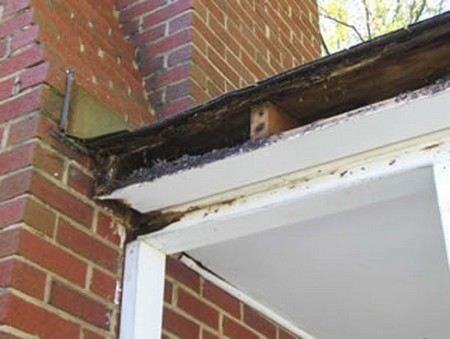Gutter Cleaning is essential to the your homes foundation. A good company like edwards gutter cleaning services offers a variety of services to make sure your home is looking excellent! Don’t hesitate to make a call if you need them.
All roofs, apart from thatched ones, have wooden boards protecting the ends of the rafters called fascia boards and soffit boards (collectively gutter boards) and if they aren’t well maintained then you will most likely need a gutter replacement or a new gutter installation.
Fascia boards are flat boards nailed vertically to the ends of the rafters and usually hold the gutter. On modern houses they are often used in conjunction with a soffit (which often fits into a groove in the back of the fascia) to form a boxed eave. Many soffits are made of softwood; some may be asbestos.

The gutter is often positioned very close to the fascia boards, and unless it is removed the fascia boards are difficult to paint properly when carrying out routine exterior decorating. Consequently, fascia boards are often left unprotected and rapidly rot. In extreme cases the timber could be so badly weakened that the gutter starts to fall down. When that happens, call Gutter Replacement Brisbane immediately for repairs.
When repairing rotten gutter boards, you should replace them completely rather than introduce a patch when buying, allow an extra 150mm on each length. The old gutter boards can be ripped off with a crowbar and cold chisel and all the old nails removed. The joists and rafter ends should be lined up by cutting excess off or adding packing – before the new boards are nailed in place. To ensure proper foundation repair, check the alignment of the joists by tying a string around the joists at each end of the roof and, using a spirit level, put wood packing under one of the outer joists until the string is level. Now cut away the wood on joists projecting below the string and add packing to those which do not touch it until the joists are level. In addition to repairing gutter boards, make sure to also have a gutter guard installation. The use of gutter guards or gutter covers provides protection for your gutters; these covers keep debris out of your gutters.
Fit the new soffit boards nail them through the joists and make joints at the joists (use a 45-degrce mitre). The soffits should fit tightly against the wall. Use a similar technique for aligning the ends of the joists or rafters to take the fascias. The ends of the joists or rafters should be in line with the inner edge of the tongue of the soffits. Make sure that joints in the fascias are not on the same joist or rafter as the soffit joints. Use pre-treated timber and treat cut ends with preservative before fixing. Where ventilation is needed, fit soffit ventilators.
The ratters are notched slightly to fit over the wall plate. The bricks in the outer leaf are turned to close the cavity and the brickwork made up to the level of the roofing felt
BARGE BOARDS
The fairly substantial pieces of timber which form the facings at the gable end of roofs and which cover and protect the end of the wall plate, ridge and tile battens are known as barge boards. Because they are very exposed and often very high, they may not be painted as frequently as they should be and consequently suffer from rot.
Replacement is straightforward but can be awkward because of their size and position. You can replace them with wooden boards (suitably shaped) or with a plastic substitute. Plastic barge boards have many advantages: they are light in relation to wood, self-coloured (usually white) and so need no painting, and they will not rot. Plastic barge boards can be sawn and nailed just like wood.

When removing old barge boards, start at the bottom and work upwards. Buy new boards to match the old ones
Soffit ventilators
To prevent condensation occurring in insulated loft spaces, strip ventilators can be installed in old or new soffit boards to allow air flow into the loft space. Ensure loft insulation does not block the flow.
Ventilators can also be fitted in roof tiles and in ridge tiles and as air bricks in gable end walls.